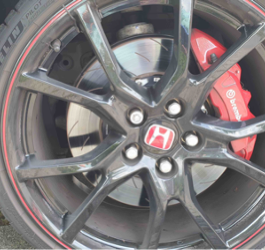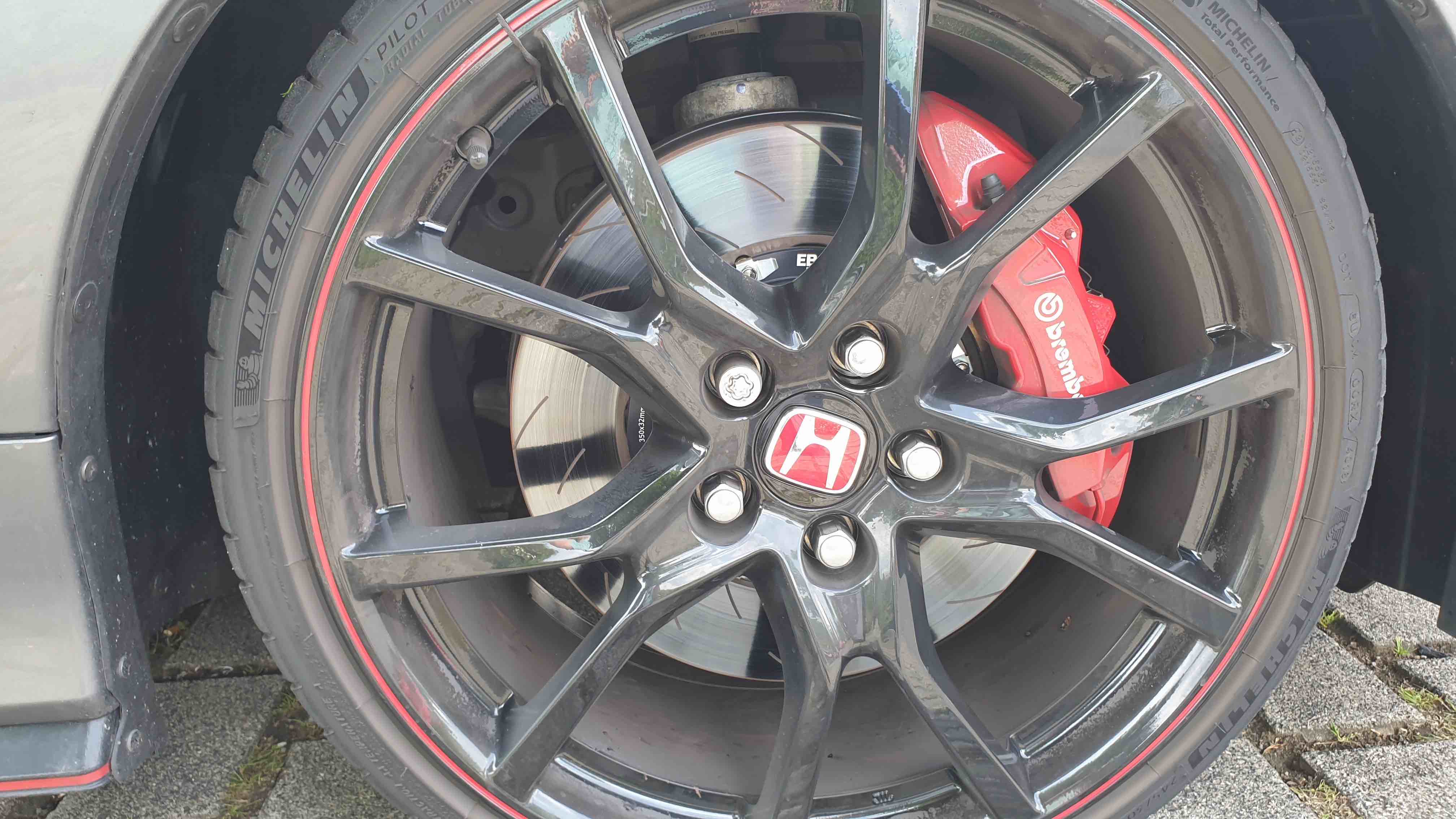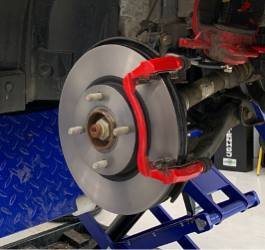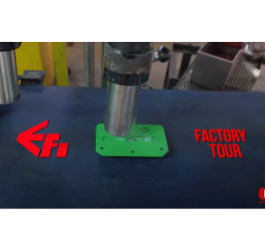How To - Bed-in New Brakes

Bedding in new brakes is an important process to maximise braking performance. The idea is to generate considerable brake temperature which burns off any lingering volatiles in the brake pads, whilst depositing an even transfer layer of pad material onto the brake rotors. After pre-conditioning the brake components to higher temperatures, the next time they ‘see’ a high temperature they will primed to deliver peak performance.
Following this bedding-in guidance will also prevent thermal shock to new brake rotors, maximise pad wear life and minimise brake noise.
The bedding-in process can be separated into two distinct stages:
Stage 1 – Mechanical bedding
Stage 2 – Thermal bedding
It’s important to note that different brake pad materials often require different bedding-in procedures; how the vehicle will be driven is also a factor. This ‘how to’ guide will clearly explain how to perform the bedding-in process correctly for every EBC brake pad and rotor type.
Perform the below procedure on a quiet, safe stretch of road or racetrack. Obey local traffic laws. Do NOT come to a complete stop whilst the brakes are hot (unless in event of emergency).
NOTE: Since new brake rotors must always be installed with new brake pads, EBC does not have a ‘rotor bedding-in procedure’ per se. To bed in new rotors, simply follow the bedding-in procedure for the new pads.
STAGE 1 – Mechanical Bedding
First, establish full contact between the brake pads and the rotor. Typically, this occurs after 50-100km of ‘normal’ road driving, however, this process may take considerably longer if new pads are installed on poor-conditioned used rotors (if a used rotor has a pronounced lip, it should be replaced before installing new pads).
A visual inspection of the brake rotor will verify if the pads have achieved full contact. There should be no banding on the brake rotor or any sign that the pad is not sweeping the full width of the rotor annulus.
For track-only vehicles, mechanical bedding can be performed on track by driving 4-6 laps at a 70% pace whilst using the brakes lightly. After doing a cool-down lap, come into the pits to verify full contact has been achieved. The rotors should have an even, dull grey appearance across the entire braking annulus.
It is normal for the brake pedal to feel slightly soft or spongey before the pads have established full contact. The pedal feel will noticeably improve once full contact has been achieved.
The brakes will emit more dust than usual during this phase of the bedding-in process. This is due to the accelerated wear rate as the pad conforms to the brake rotor.

STAGE 2 – Thermal Bedding
Before we begin, it is important to distinguish between the two different types of brake fade:
Early-life Fade (or Green Fade) is a reduction in braking performance that occurs the first time the pads ‘see’ elevated temperature. It is caused by lingering volatiles in the pad post-manufacture. It occurs once, and only once; the next time the pads ‘see’ that same temperature they will be pre-conditioned for it and will not drop in performance. Early-life fade can be mitigated by following the manufacturer's recommended bedding-in procedure, as detailed in this guide.
Dynamic Brake Fade is a reduction in braking performance that occurs when the designed operating temperature of the pad material is exceeded. It will occur each and every time the pad ‘sees’ that temperature. All brake pad friction materials are engineered to maintain their performance over a certain temperature range, alas, the only way to remedy dynamic brake fade is to swap the pads to a different material that has a higher thermal handling capacity. Dynamic brake fade cannot be prevented or corrected by reperforming the bedding-in routine. If you are experiencing dynamic brake fade, please contact us and our knowledgeable technical team will be happy to run through some options with you.
As stated earlier, different pad materials require different bedding-in procedures. How the vehicle is intended to be driven is also an important factor. For ‘daily driver’ vehicles driven exclusively on public roads and never pushed hard, minimal thermal bedding is required; normal road driving does not generate temperatures above 300 centigrade and therefore it simply isn’t necessary to pre-condition the pads to a higher temperature. Conversely, for performance-oriented vehicles driven hard on twisty roads or on track, a more thorough thermal bedding procedure is necessary to condition the pads for the higher temperatures achieved during performance driving.
The table below can be used to look up the requisite bedding-in steps for the EBC brake pads you are using. At the bottom of this article, you will find detailed steps for performing each fade procedure. For example, if you fitted YellowStuff pads and planned on doing the occasional trackday, you would perform Fade 1 + Fade 2 + Fade 3 procedures in that order.
|
EBC Friction Material |
Bedding-in Procedure |
| Ultimax | Fade 1 |
| GreenStuff | Fade 1 + 2 |
| RedStuff | Fade 1 + 2 |
| YellowStuff | Fade 1 + 2 (Fade 3 optional if used on track) |
| BlueStuff | Fade 1 + 2 (Fade 3 optional if used on track) |
| RP-1 | Fade 3 + 4 |
| RP-X | Fade 3 + 4 |
| SR-11 | Fade 5 |
| SR-21 | Fade 5 |
It is normal for the brakes to fade, produce some smoke and smell strongly during the bedding-in procedure.
NOTE: For reference, a full ABS-assisted emergency stop is around 1.0g of deceleration in most cars. Alas, when we say ‘0.4g decel’ we mean a moderate rate of deceleration which is roughly half that of an emergency stop. When we say ‘0.8g decel’ we mean a high rate of deceleration which is getting close to an emergency stop, but without causing the ABS to engage.
FADE PROCEDURES
FADE 1 Perform 10 medium snubs from 100kph to 30kph leaving 300 meters between each snub (approx 0.4g decel). Drive for 5km at 60kph with minimal brake usage to cool the brakes. Allow the brakes to fully cool for at least 1 hour or overnight before progressing to the next stage (if applicable).
FADE 2 After performing Fade 1, perform 6 high-pressure snubs from 110kph to 20kph with maximum acceleration between consecutive snubs (approx 0.8g decel). Drive for 5km at 60kph with minimal brake usage to cool the brakes. Allow the brakes to fully cool for at least 1 hour or overnight before progressing to the next stage (if applicable).
FADE 3 After performing Fade 1 + 2 (if applicable) perform 10 high-pressure snubs from 140kph to 50kph with maximum acceleration between consecutive snubs (approx 0.8g decel). Drive for 5km at 60kph with minimal brake usage to cool the brakes. Or if on track, drive 3 laps at 80% pace, followed by a cooldown lap before returning to the pits. Allow the brakes to fully cool for at least 1 hour before progressing to the next stage (if applicable).
FADE 4 After performing Fade 3, perform 10 high-pressure snubs from 180kph to 50kph with maximum acceleration between consecutive snubs (approx 0.8g decel). Drive for 5km at 60kph with minimal brake usage to cool the brakes. Or if on track, drive 5 laps at 90% pace, followed by a cool-down lap before returning to the pits. Allow the brakes to fully cool for at least 1 hour before progressing to the next stage (if applicable).
Perform 5 recovery stops with low pressure from 140kph to 80kph leaving approx 600 meters between each stop. Or if on track, drive 2 laps at 60% pace then return to the pits.
FADE 5 For sintered SR-11 and SR-21 materials only. Sintered friction materials are unique in that they never experience brake fade; there is nothing in the pad that could break down at elevated temperatures and lead to brake fade. Alas, bedding-in of sintered materials simply requires the pads to establish full contact with the brake rotor. Drive 2 laps at 80% pace then return to the pits. Visually inspect the brake rotor to ensure full contact has been achieved. If the pads have not yet established full contact, drive another 2 laps and repeat. Once the pads have achieved full contact, proceed at full racing speeds (and prepare to experience the best brakes of your life).




Validate your login